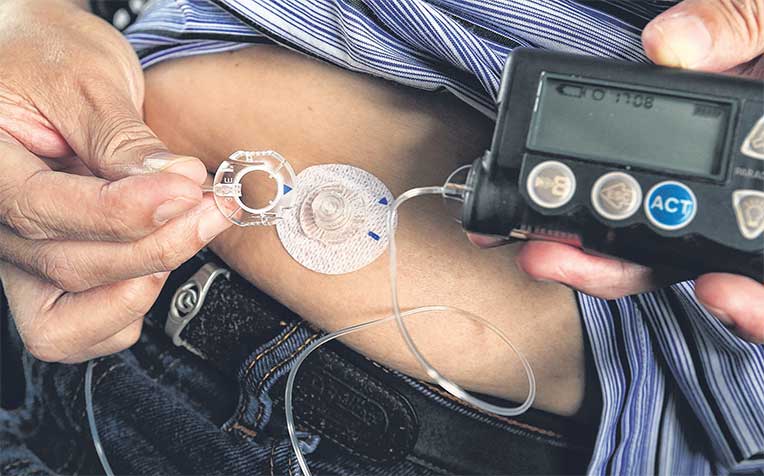
contains a syringe-likeinsulin reservoir with about three days’ supply.
Multiple insulin injections were a part of Mr Char Wei Meng’s daily routine for the past 30 years.
These injections are necessary as he has Type 1 diabetes – his body produces no insulin due to damage in the pancreas. Insulin is needed to break down the sugar we consume into energy.
Mr Char, 49, a supply planner, said: “No one wants to have to keep injecting themselves.”
A year ago, he was introduced to insulin pump therapy by doctors at the Singapore General Hospital (SGH) which, among other things, reduced the need for injections from up to four times a day to once every three days.
Hospitals have been offering it to patients on a larger scale in recent years, but demand has been slow.
For example, SGH started 30 patients on the pump in the past two years and it has 45 pump users now.
This is a mere fraction of the estimated 5 to 10 per cent of more than 400,000 people in Singapore who have Type 1 diabetes.
At National University Hospital (NUH), only 13 per cent of paediatric patients with Type 1 diabetes are on insulin pump therapy. The insulin pump is a battery-operated device about the size of a pager that contains a syringe-like insulin reservoir with about three days’ supply.
This supply runs through a tube into a plastic cannula (a thinner tube containing a needle) that sits under the skin, delivering the insulin continuously into the body.
Diabetes is characterised by high blood sugar levels that are a result of the body producing insufficient insulin. In Type 1 diabetes and severe cases of the more common Type 2, the insulin deficiency is serious enough to require regular insulin boosts.
Delivering the insulin to one’s body is a complicated affair and Type 1 patients –often diagnosed in their teens – have to learn to do it on their own for most of their lives.
Dr Daphne Gardner, a consultant at SGH’s department of endocrinology, said: “Insulin delivery has two components – a background rate which runs continuously over 24 hours keeping your blood sugar levels stable, and a bolus dose which covers insulin requirements for the food you eat.”
When Mr Char was using an insulin pen, it meant four injections a day – once for the background insulin and thrice for each meal.
With the pen, he said he had to check the carbohydrate content of his food and calculate the amount of insulin needed. If he miscalculated, more injections would be needed as corrections.
Mr Char said: “With the pump, you just need to input the numbers (such as carbohydrate content and blood sugar levels) and the device will give you the estimate for how much insulin is needed.”
Correcting the dosage is done by pressing buttons on the device.
Dr Cindy Ho, an associate consultant at NUH’s division of paediatric endocrinology, said: “Insulin pump therapy gives patients the flexibility to administer the bolus dosage only when they sit down to eat.
“It allows them to vary their activities as they can adjust the background insulin administered on an hour-by-hour basis.”
The insulin pump can administer more precise dosages of insulin than the insulin pen. This means a lower risk of hypoglycaemia, when blood sugar levels become dangerously low, potentially causing seizures and loss of consciousness.
Despite the significant improvements, most diabetes patients here who need insulin replacement are still on daily injection therapy.
One major obstacle is cost. Dr Ho said: “The insulin pump itself costs a few thousand dollars, depending onthe brand and model.”
Users have to pay for things such as the tubing and insertion set, and the insulin supply. Mr Char said his pump cost close to $6,000.
Patients also need to learn to use the pump effectively. For example, changing the insulin supply every three days is more complicated than using a pen. And some patients dislike having the pump attached to their bodies all day.
But the pump has been a boon for Mr Char. “The important thing is to live normally and be happy,” said the food lover, who is married with a 12-year-old daughter.
“Putting on the pump is so convenient. You can eat at any time you like and, if needed,make the corrections afterwards.”
Contributed by














 Get it on Google Play
Get it on Google Play